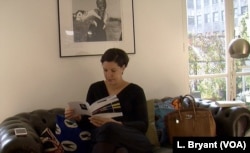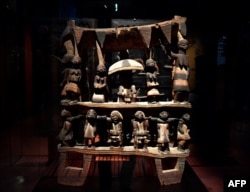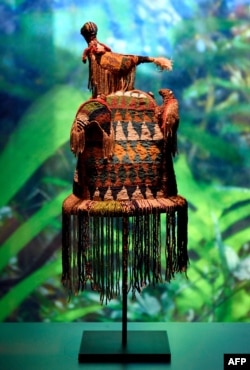When a private museum in Benin displayed artifacts from the ancient Dahomey kingdom a decade ago, roughly a quarter-of-a-million Beninese flocked to see the exhibit — a stunning turnout for the tiny West African country.
There was only one hitch: although the pieces were part of its heritage, they didn't belong to Benin, but rather were on loan from former colonial power France.
The next time Benin exhibits Dahomey art may be under very different circumstances. France has promised to return 26 royal artifacts taken by the French army in 1892—a move that may prove a watershed for other African restitution claims.
"If Benin succeeds in showing its heritage I think everything will change," says Marie-Cecile Zinsou, a French-Beninese who counts among Africa's most vocal restitution advocates and whose Zinsou Foundation hosted the Dahomey exhibit in 2006. "Then you'll have a real example of how African countries are getting their heritage back and showing it to the public. Then people will believe."
Macron report recommends return
After years of rebuffing restitution arguments, France is now catalyzing new hope — and concern — that tens of thousands of artifacts taken from former African colonies might head back to their places of origin. The first signs of a turnaround came in Burkina Faso last year, when French President Emmanuel Macron promised to temporarily or permanently return Africa's patrimony to the continent within five years.
The latest breakthrough came in November, when a pair of academics delivered a groundbreaking report, commissioned by Marcon, which recommended France permanently return objects acquired through "theft, looting, despoilment, trickery and forced consent."
In a continent where 60 percent of the population is under 20, young people should have "access to their own culture, creativity and spirituality from other eras," Senegalese economist Felwine Sarr and French historian Bénédicte Savoy wrote. "The youth of Africa as much as the youth of France and Europe in general, have a right to their artistic and cultural heritage."
Today, the report is sparking cascading restitution claims in Africa, although most are not yet official. Benin, which for years demanded its plundered artifacts be restored, is the first beneficiary.
But others include Ivory Coast and Senegal, where Senegalese Culture Minister Abdou Latif Coulibaly said "if we have 10,000 (objects in France), we want the 10,000."
Museum directors in Mali and Chad have announced their countries were ready and able to house artifacts currently located in France and elsewhere. And in Democratic Republic of Congo, President Joseph Kabila said he would officially request former colonial power Belgium to return objects acquired during years of brutal rule.
The French report is also sparking some action in other western countries.
Last week, the United Nations General Assembly adopted a resolution supporting returning objects to their countries of origin, calling on member states to create databases and step up the fight against art trafficking. The British museum has promised to return priceless bronzes to Nigeria. And Germany is helping Kenya track its valuable stolen artifacts that ended up in western museums, including German ones.
Powering restitution arguments is a sobering statistic: up to 90 percent of African antiquities are located outside the continent. That includes in France, where an estimated 90,000 African artifacts are housed in French museums, mostly the Quai Branly-Jacques Chirac museum in Paris.
Where to house returned artifacts?
Meanwhile, new museums are sprouting or in the works across Africa, which — according to proponents — counters arguments the region cannot properly house its heritage. Senegal's Museum of Black Civilizations opened its doors in Dakar earlier this month, while last year Ivory Coast reopened its national museum that had been shuttered during a protracted civil war. Gabon, DRC and Benin are also in the process of building or revamping art spaces.
"African countries will obviously deal with their heritage, that's not a question," says Zinsou, who notes Benin has announced it would open three museums and renovate six others.
Some are not so sure. "We know the shortage in African museums" of proper conservation, art expert Alexandre Guigello told Agence France-Presse news agency, reflecting concerns echoed in other European capitals.
France's culture minister supports loaning artifacts to Africa rather than permanent returns, while Quai Branly museum head Stephane Martin described the restitution report as a bad answer," telling Le Figaro newspaper there were "other ways to engage in cultural cooperation with Africa."
Former French culture minister Jean-Jacques Aillagon offered a more dramatic response, predicting in a Le Figaro op-ed that returning the artifacts would "empty the museums," leaving only copies.
Indeed, the report raises a slew of questions about the fine print of restituting African heritage— and suggests French law, enshrining the inalienability of public collections, must be changed to do so.
"It is also not clear what exactly Macron's temporary or definitive restitution' entails," adds Charline Kopf, a doctoral researcher at the University of Oslo who has examined the debate.
Returning art to places whose borders have shifted over the years poses still other headaches. While current restitution claims are being made by African nations, "sometimes such claims are also made by indigenous communities … and do not neatly correspond to boundaries on a map," Kopf adds.
Robert Jonard, who sells African artifacts in Paris, says smaller dealers like himself aren't worried they may lose ownership of their most valued pieces. "It's mostly a discussion at a higher level, among leading experts and museum heads," he says.
Like other skeptics, Jonard is worried about returning precious artifacts to places where they risk being looted or badly cared for. He claims many were originally crafted for purely practical purposes, and their original owners had few qualms about destroying or selling them when their use ran out.
"Consider what might happen to French museums if all the art Napoleon plundered in Italy was sent home?" Jonard adds. "What will remain in the world's museums if each country asks for its art back?"














